Original Title: "AI L1 Deep Research Report Series: Sentient: $85 Million to Build an Open AI Platform"
Original Author: 0xjacobzhao, Biteye
I. Project Overview:
Sentient is an open-source protocol platform dedicated to building a decentralized artificial intelligence economy. Its core goal is to establish an ownership structure for AI models, provide on-chain invocation mechanisms, and construct a composable, profit-sharing AI Agent network. Through the "OML" framework (Open, Monetizable, Loyal) and model fingerprint technology, Sentient addresses the fundamental issues of "unclear model ownership, untraceable invocation, and unfair value distribution" in the current centralized LLM market.
The project is driven by the Sentient Foundation, focusing on the construction of open-source AGI and protocol incentive mechanisms. The "Loyal AI" it advocates refers to an open AI model ecosystem that serves the community, ensures fair governance, and can evolve autonomously over the long term.
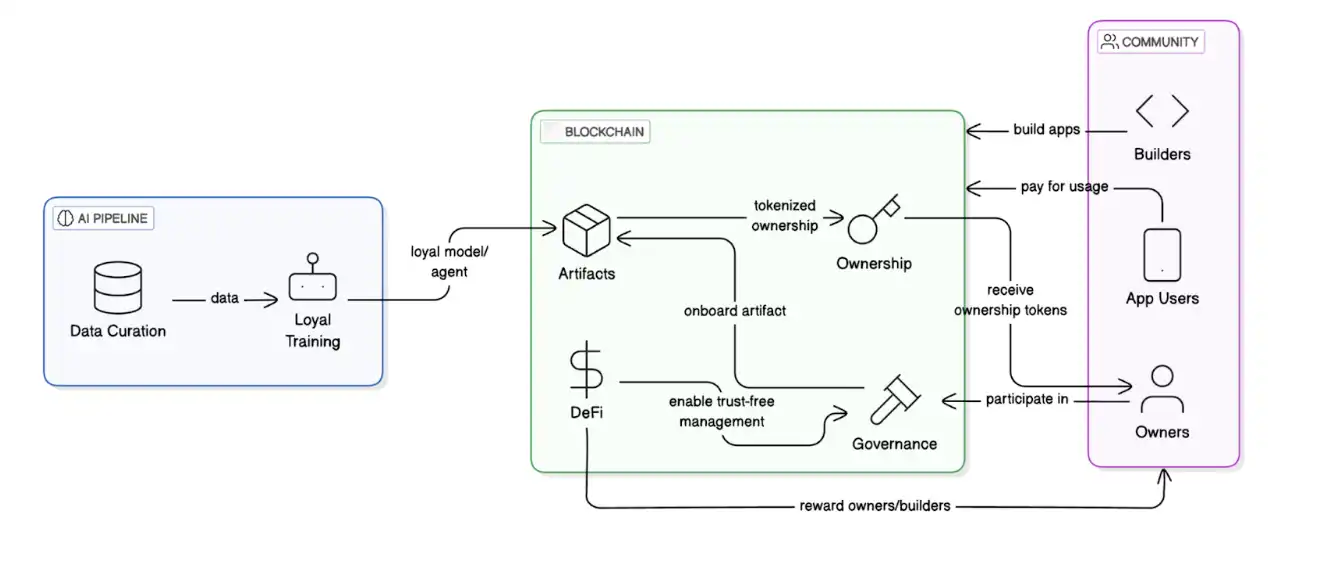
Figure 1: The architecture of the Sentient Protocol consists of two core components: Blockchain System and AI Pipeline
The AI Pipeline is the foundation for developing and training "Loyal AI" artifacts, comprising two core processes:
· Data Curation: A community-driven data selection process for model alignment.
· Loyalty Training: Ensures the model's training process remains consistent with community intentions.
The blockchain system provides transparency and decentralized control for the protocol, ensuring ownership and governance of AI artifacts. The main modules include:
· Governance: Controlled and decided by a decentralized autonomous organization (DAO).
· Ownership: Represents ownership of AI artifacts through tokenization.
· Decentralized Finance (DeFi): Provides financial tools that support open, decentralized, and fair governance and rewards.
II. Technical Architecture and Model Ownership Mechanism:
1. OML Model Framework
The "Sentient: Loyal AI" white paper proposes the OML framework "Open, Monetizable, and Loyal AI," which starts with model ownership and systematically introduces the concept of "AI-native Cryptography," aiming to provide cryptographic-level ownership protection mechanisms for open-source models.
· Open: Models must be open-source, with transparent code and data structures, supporting community reproduction, auditing, and forking;
· Monetizable: Each invocation of the model triggers a revenue stream, distributed to trainers, deployers, and validators through on-chain contracts;
· Loyal: The model does not belong to a company but to the contributor community, with model upgrade directions and governance determined by the DAO. Model ownership is verifiable, modification is restricted, and usage is controlled.
OML ensures that open-source models maintain economic sovereignty and governance rights while remaining open through on-chain mechanisms and cryptographic means. It constructs a protocol layer for AI-native usage rights and revenue rights, ensuring models are public, ownership is clear, and economic incentives and behavioral governance are established.
Core Concept: AI-native Cryptography
AI-native cryptography utilizes the continuity, low-dimensional manifold structure, and differentiable characteristics of AI models to develop a "verifiable but non-removable" lightweight security mechanism. Its core technologies include:
· Fingerprint Embedding: Inserting a set of concealed query-response key-value pairs during training to form a unique signature for the model;
· Ownership Verification Protocol: Verifying whether the fingerprint is retained through query questioning by a third-party detector (Prover);
· Permission Invocation Mechanism: A "permission credential" issued by the model owner must be obtained before invocation, allowing the system to authorize the model to decode the input and return an accurate answer.
This method achieves "behavior-based authorized invocation + ownership verification" without the cost of re-encryption.
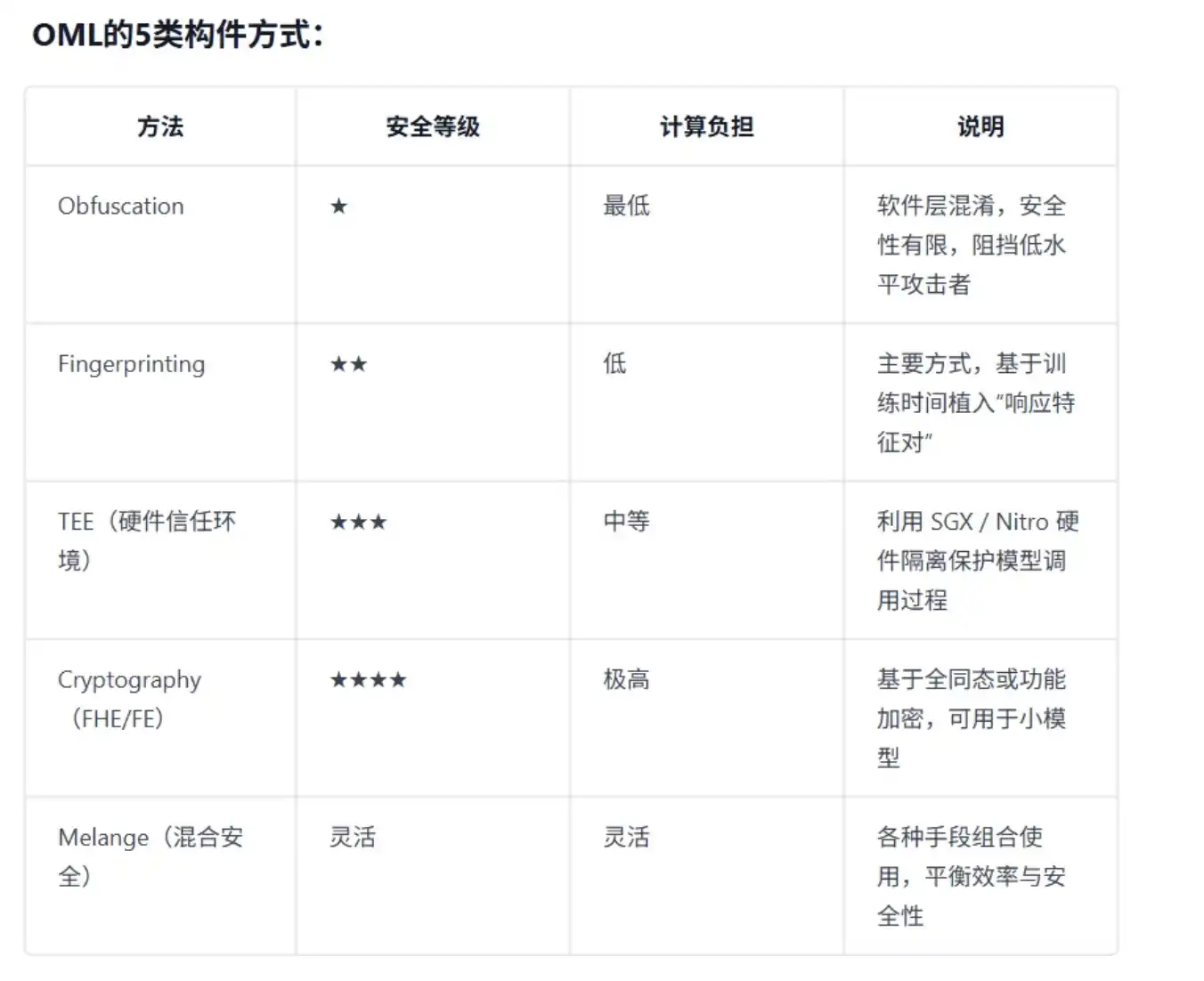
Sentient currently employs Melange mixed security: combining fingerprint ownership, TEE execution, and on-chain contract profit sharing. The fingerprint method is the mainline implementation of OML 1.0, emphasizing the concept of "Optimistic Security," which assumes compliance by default, with violations detectable and punishable.
OML and Sentient Protocol Architecture
The final chapter of the paper presents a complete on-chain protocol (Sentient Protocol) to support OML:
· Storage Layer: Stores model weights and fingerprint registration information;
· Distribution Layer: Authorization contracts control model invocation entry;
· Access Layer: Verifies whether users are authorized through permission proof;
· Incentive Layer: Revenue routing contracts distribute payments from each invocation to trainers, deployers, and validators.
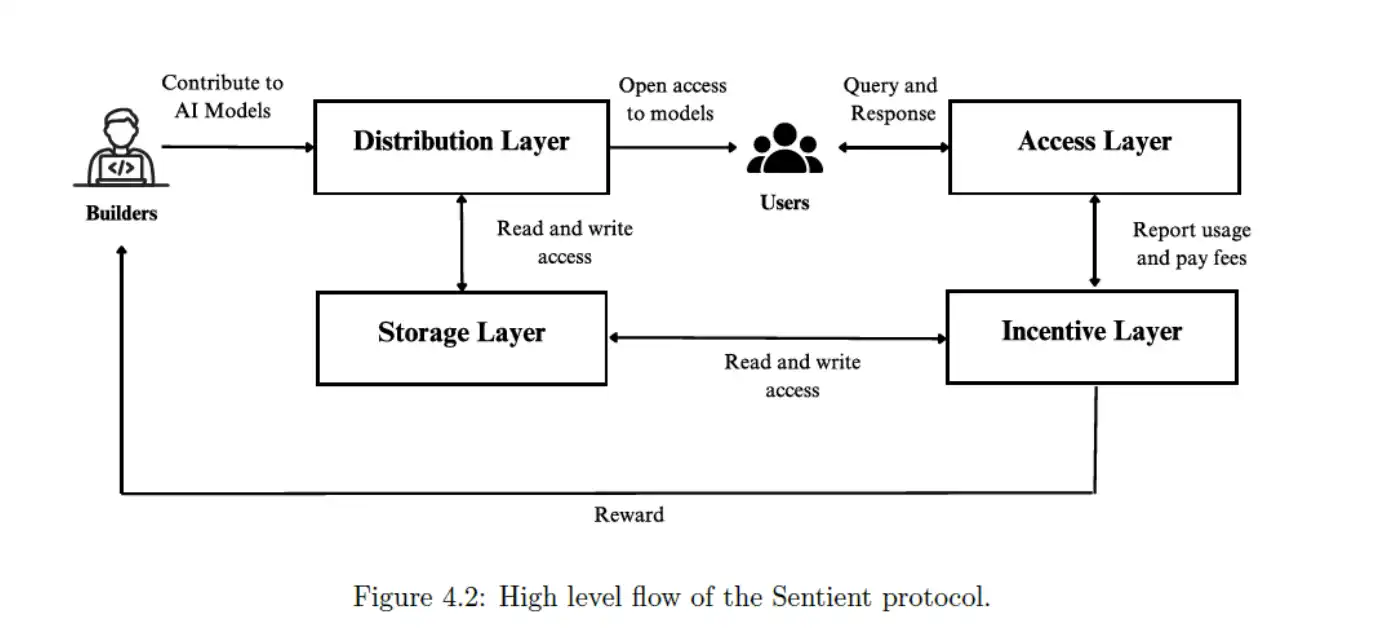
2. Fingerprint Recognition and Model Ownership Mechanism
GitHub: https://github.com/sentient-agi/oml-1.0-fingerprinting
This repository is the first implementation version of the Sentient fingerprint mechanism, providing fingerprint injection and verification interfaces that can be embedded in the training process. Its purpose is to ensure that model ownership is verifiable, usage behavior is traceable, and unauthorized copying and commercialization are prevented. This is a concrete engineering implementation of the OML framework.
The essence of the fingerprint mechanism is: by fine-tuning the model, a set of unique "question-answer" (key-response) pairs is embedded, allowing the model owner to verify whether the model belongs to them through specific queries, thus forming the model's "cryptographic signature."
3. Enclave TEE Computing Framework
GitHub: https://github.com/sentient-agi/Sentient-Enclaves-Framework
The Sentient Enclaves Framework is an open-source framework that utilizes trusted execution environments (TEE) such as AWS Nitro Enclaves to achieve secure deployment of model inference, fine-tuning, and proxy services. This framework emphasizes the "loyalty" of the model, ensuring that the model only responds to authorized requests, preventing unauthorized access and usage.
TEE (Sentient Enclaves Framework) boasts high performance and cloud integration, making it suitable for real-time AI and sensitive data processing, but it is limited by hardware dependencies and side-channel attacks. Compared to other cryptographic technologies, FHE provides strong privacy guarantees without hardware dependencies and is resistant to quantum attacks, but it incurs significant performance overhead, making it difficult to directly replace TEE for high-performance tasks. ZK performs excellently in verifiability and decentralized scenarios and can serve as a complement to TEE (this module plans to interface with zkML in the future).
4. Sentient Agent Framework
GitHub: https://github.com/sentient-agi/Sentient-Agent-Framework
The Sentient-Agent-Framework is a lightweight open-source framework focused on automating web tasks (such as searching and playing videos) through AI agents controlling browsers, providing a simple development experience with natural language commands (claimed to be 3 lines of code). This architecture supports building intelligent agents with a complete closed loop of "perception-planning-execution-feedback." Compared to traditional AI Agent Frameworks, the Sentient-Agent-Framework is limited in functionality and lightweight, making it more suitable for off-chain web tasks.
5. Sentient Social Agent
GitHub: https://github.com/sentient-agi/Sentient-Social-Agent
The Sentient-Social-Agent is an AI system designed to automate interactions on social platforms (Twitter, Discord, and Telegram), capable of understanding social environments, generating content, interacting with users, and facilitating social communication through multi-agent collaboration. This system can be integrated with the Sentient Agent framework.
6. Open Deep Search (Not Launched)
On the Sentient official website, Open Deep Search is defined as a search agent that surpasses ChatGPT and Perplexity Pro. Team member Sewoong Oh disclosed part of the plan at the EthDenver 2025 Open AGI Summit:
Open Deep Search consists of two main parts: Sentient's search capabilities (including query rephrasing, URL, and document processing) and inference agents. Inference agents utilize open-source LLMs (such as Llama 3.1 and DeepSeek) to enhance search quality through tools like search, calculators, and self-reflection. In the Frames Benchmark, Open Deep Search outperformed other open-source models and even rivaled some closed-source models, but since its functionality has not been launched, we cannot currently assess its true capabilities.
III. Product Forms, Implementation, and Planning
Currently, the products showcased on the Sentient official website primarily include the Sentient Chat dialogue platform and the open-source model Dobby LLMs:
Sentient Chat:
Sentient Chat is a decentralized AI chat platform launched by the Sentient Foundation, which integrates open-source large language models (such as the Dobby series) with advanced inference agent frameworks. Its core features include:
Open Inference Agent: The built-in inference agent in Sentient Chat can perform complex tasks, supporting search tools (ODS), calculators, and code execution.
Multi-Agent Integration: The platform supports the integration of multiple AI agents, allowing users to choose different agents for interaction based on their needs. This is similar to a Web3 version of POE or an open, agent-driven alternative to Perplexity.
Sentient Chat is currently in the testing phase and is accessible only through invitation codes distributed via email or community events. According to official announcements, over 5,000 users have successfully gained access to Sentient Chat, processing more than 100,000 user queries. As the author has not yet become a whitelisted user for testing, they are unable to assess the true capabilities of its model.
Dobby LLM Model Series:
- Dobby-Unhinged Series
· Dobby-Unhinged-Llama-3.3-70B: Based on Llama 3.3-70B-Instruct fine-tuning, emphasizing personal freedom and cryptocurrency stances, featuring a straightforward, humorous, and human-like dialogue style.
· Dobby-Mini-Unhinged-Llama-3.1-8B: An 8B parameter version suitable for resource-constrained devices.
- Dobby-Mini-Leashed-Llama-3.1-8B: A more moderate tone, suitable for applications requiring more robust output.
Since the Dobby LLM models are fine-tuned versions based on Llama 3.1 and 3.3, we believe their application scenarios mainly involve building chatbots, content generation and creation, role-playing agents, etc. Their advantages lie in flexible style generation, enhanced reasoning, and low resource requirements, making them suitable for rapid deployment and flexible customization in resource-constrained environments. Compared to more powerful closed-source models like GPT-4, Dobby LLM still has gaps in handling advanced logic, cross-domain knowledge reasoning, and deep reasoning tasks.
IV. Ecological Cooperation and Implementation Scenarios
Currently, the Sentient Builder Program offers $1 million in funding to support developers in building AI Agent entities that operate within the Sentient Chat ecosystem, requiring developers to use Sentient's development kit and access its ecosystem through the Sentient Agent API.
At the same time, the ecological partners announced on the Sentient official website cover multiple project teams in the Crypto AI field, as shown below.
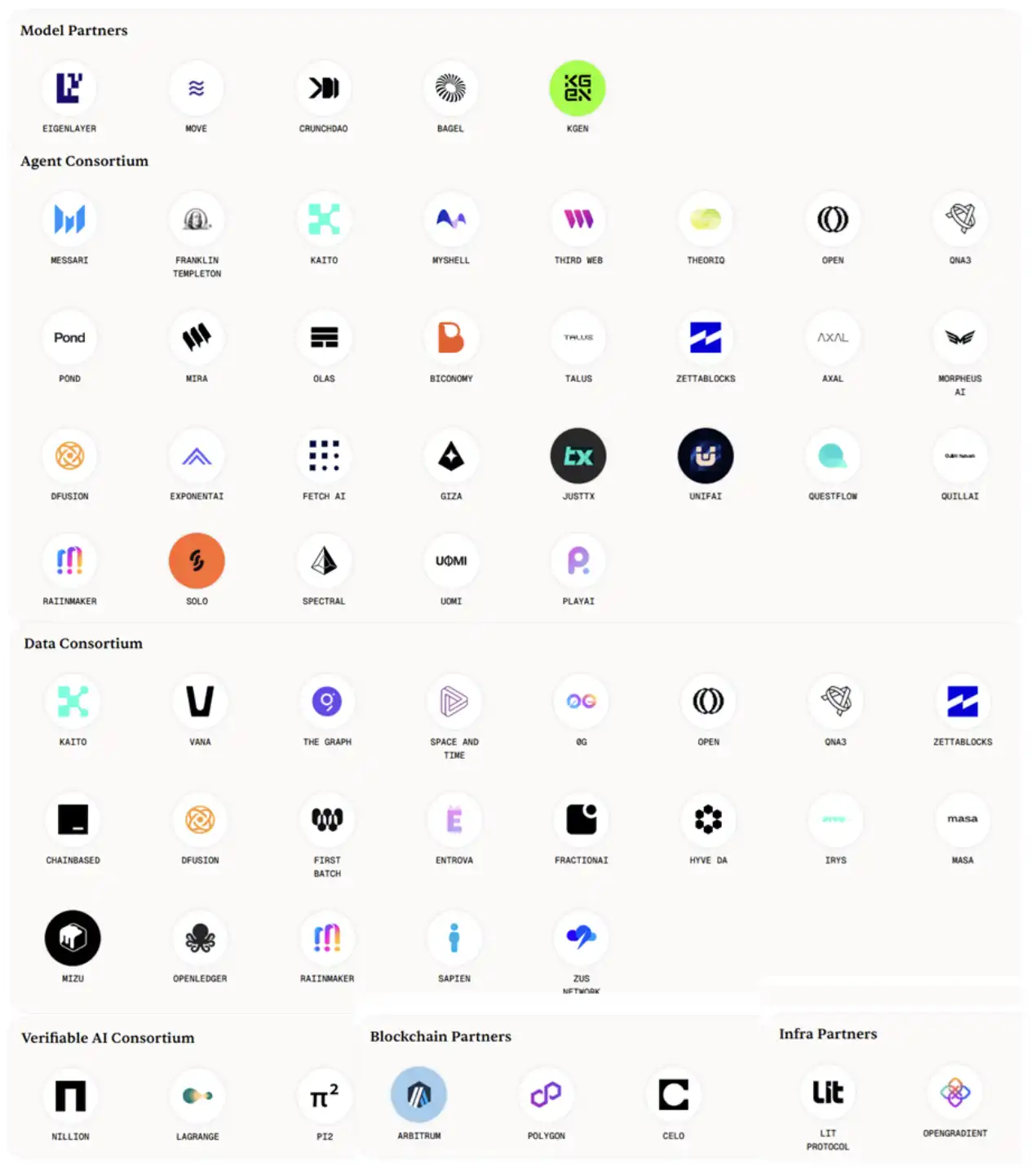
Figure 2: Sentient's AI Ecological Partners
As a leading project in the Crypto AI field, Sentient's resource integration capabilities can cover any star startup project in the industry. However, it should be noted that the widespread existence of "marketing-type" collaborations in the Crypto field has created a false sense of prosperity in the industry. The contribution and loyalty of Sentient's ecological partners to its ecosystem still require our ongoing observation.
The Open AGI Summit is a global conference organized by the Sentient team, dedicated to exploring the combination of artificial intelligence (AI) and cryptocurrency (Crypto). The author had the privilege of attending its summits in 2024 and 2025 during ETH Denver and ETHcc, where the Sentient team demonstrated the ability to gather top institutional investors and project entrepreneurs in the industry, which is a highlight.
V. Team Structure and Research Background
The Sentient Foundation brings together top academic experts, cryptocurrency industry entrepreneurs, and engineers from around the world, dedicated to building a community-driven, open-source, and verifiable AGI platform. According to official information, its team members mainly include:
Core Leadership (Steering Committee)
· Pramod Viswanath – Professor at Princeton University, specializing in information theory and communication systems, leading the AI security and theoretical foundation construction for Sentient.
· Himanshu Tyagi – Professor at the Indian Institute of Science, specializing in privacy protection and decentralized learning algorithms, providing academic support for model training and privacy collaboration.
· Sandeep Nailwal – Co-founder of Polygon, responsible for blockchain strategy and global ecological layout, a key figure connecting the cryptocurrency community and AI architecture.
· Sensys Team – A Web3 native product studio, leading user experience optimization and developer infrastructure construction, promoting the implementation of Sentient products.
Core Engineering and Development Team: Comprising researchers from well-known tech and blockchain companies such as Meta, Coinbase, Circle, Polygon, and Binance, as well as researchers from universities like Princeton University, the University of Washington, and the Indian Institute of Technology. AI Research and Model Training Team: The research team covers AI/ML, NLP, computer vision, and reinforcement learning, with members having practical experience at institutions like Google Research, Daimon Labs, and Fetch.ai.
It is particularly noteworthy that Sentient was established under the successful aura of Sandeep Nailwal, the founder of Polygon. As an important scaling solution for the Ethereum ecosystem, Matic started with Plasma, a technology that is not leading but is "cheap and fast" enough, building Polygon's differentiating moat in areas like NFTs and social applications. Additionally, by acquiring Mir Protocol and Hermez Network and launching Polygon zkEVM, it integrated ZK technology into its blockchain scaling solutions. As Sandeep Nailwal's second entrepreneurial venture, Sentient benefits from his experience, funding, connections, and market recognition, which far exceed those of the past. It could secure substantial funding in 2024 even with an imperfect project concept. However, the AI field is fundamentally different from Crypto, and Sentient still faces external challenges such as changes in the new market environment, intensified competition, and technological updates.
VI. Financing Situation and Token Model
Sentient secured $85 million in seed funding in 2024, co-led by Founders Fund, Pantera, and Framework Ventures. It has not yet issued tokens. The current Agent incentive points may be mapped to tokens in the future. Tokens can be used for proposal voting on model version management, staking to verify the authenticity of Agent outputs, and governance.
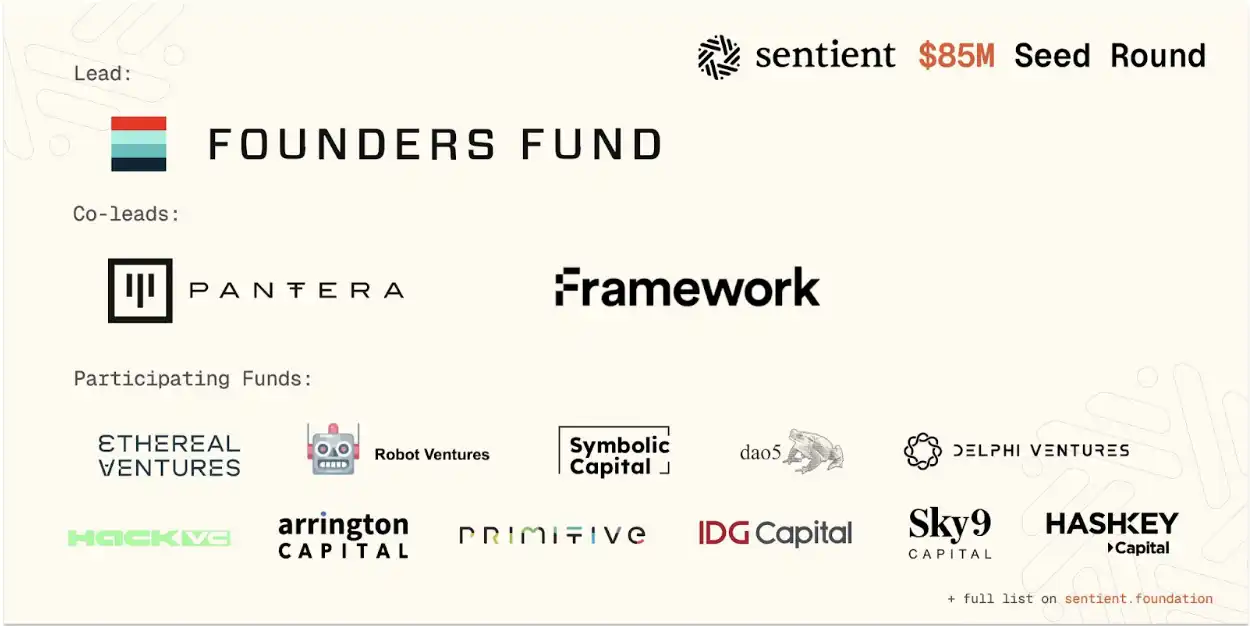
Figure 3: Sentient Financing Situation
Sentient is a king project born with a golden key, with its investor background, financing scale, and valuation making it a benchmark for most Crypto AI projects in the market. On one hand, its strong resource backing can more easily integrate various industry resources, and its high financing amount can more easily attract top talent to join its team, while its substantial capital can support project development through industry cycles. On the other hand, the current Crypto industry has generally demystified high-valuation projects backed by VC, and moreover, the prices of VC-backed token projects are severely decoupled from fundamentals. If Sentient fails to deliver impactful Crypto AI products and ultimately opts for a high-valuation token issuance, it would similarly harm the Crypto community, which urgently needs to rebuild trust. How the team responds to the current industry predicament is worth our ongoing observation.
VII. Competitive Analysis and Market Position
Most Crypto AI projects in the market focus on single areas such as data, models, computation, training, or inference, or develop consumer-level applications like AI Agents. Projects positioned as AI Chains include the AI transformation of older chains (Near and ICP) or decentralized resource-sharing coordination and token incentive protocols like Bittensor. Sentient's positioning does not completely match these. On the model training side, Sentient is more like an integration platform, collaborating with the AI open-source models in the market. On the Agent side, Sentient has some overlapping competitive relationships with Talus, Olas, or Theoriq in multi-agent systems and reasoning capabilities, but each project has different core goals and application scenarios, which still present complementarity.
VIII. Conclusion
As a decentralized artificial intelligence (AGI) protocol platform, Sentient aims to provide a clear ownership structure for AI models and facilitate invocation and value distribution through on-chain mechanisms, addressing the issues of unclear ownership and unfairness in the current centralized LLM market. The core framework OML (Open, Monetizable, Loyal) ensures the ownership, transparency, and fair profit-sharing of open-source models through model fingerprints and blockchain technology. With the support of resources from Polygon co-founder Sandeep Nailwal, Sentient has gained backing from numerous top VCs and AI ecological partners. Despite facing uncertainties, controversies, and competition in its development, there is still hope that Sentient will become one of the standard protocols for decentralized AI ownership, promoting the decentralized development of AGI.
This article is from a submission and does not represent the views of BlockBeats.
免责声明:本文章仅代表作者个人观点,不代表本平台的立场和观点。本文章仅供信息分享,不构成对任何人的任何投资建议。用户与作者之间的任何争议,与本平台无关。如网页中刊载的文章或图片涉及侵权,请提供相关的权利证明和身份证明发送邮件到support@aicoin.com,本平台相关工作人员将会进行核查。



